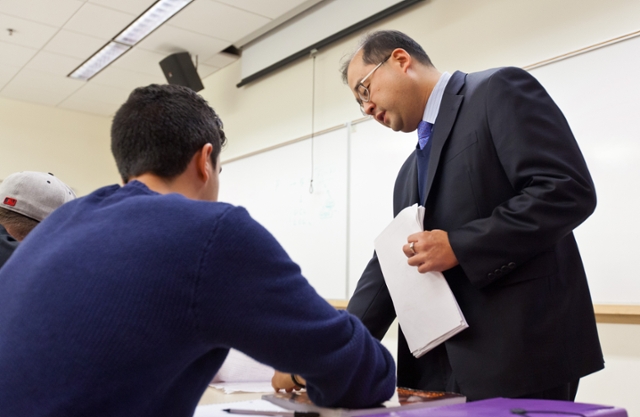Page 17 • (788 results in 0.017 seconds)
-
Graduate students from a range of disciplines (Physics, Chemistry, Materials Science, Mechanical Engineering, and Geo/Planetary Science) have a unique opportunity to study the response of materials at extreme conditions with the internationally renowned scientists at Washington State University (WSU). Working within their respective academic departments,…
PhD research in the Institute for Shock Physics (ISP), which provides tremendous learning and research opportunities through: Participation in innovative and multidisciplinary research Professional growth through independent thinking and hands-on work State-of-the-art experimental and computational facilities, including the Dynamic Compression Sector located at the Advanced Photon Source (Argonne, IL) Partnerships with exceptional faculty at other academic institutions (Caltech and Princeton
-
The Department of Energy’s (DOE) Office of Nuclear Energy (NE) announced a new request for applications (RFAs) for the Innovations in Nuclear Energy Research and Development Student Competition, seeking to recognize and award published graduate and undergraduate students for innovative nuclear energy research. This program…
Chemistry REU Program Summer 2023 Read Next Dynamic Compression Summer School LATEST POSTS Mississippi State University Now Accepting 2025 Summer REU Environmental Science Applications November 15, 2024 Dept of Energy Computational Science Graduate Fellowship October 30, 2024 2025 Fred Hutch Summer Undergraduate Research Program October 30, 2024 Allen Institute Summer Internship Program October 29, 2024
-
Graduate students from a range of disciplines (Physics, Chemistry, Materials Science, Mechanical Engineering, and Geo/Planetary Science) have a unique opportunity to study the response of materials at extreme conditions with the internationally renowned scientists at Washington State University (WSU). Working within their respective academic departments,…
PhD research in the Institute for Shock Physics (ISP), which provides tremendous learning and research opportunities through: Participation in innovative and multidisciplinary research Professional growth through independent thinking and hands-on work State-of-the-art experimental and computational facilities, including the Dynamic Compression Sector located at the Advanced Photon Source (Argonne, IL) Partnerships with exceptional faculty at other academic institutions (Caltech and Princeton
-
The Department of Energy’s (DOE) Office of Nuclear Energy (NE) announced a new request for applications (RFAs) for the Innovations in Nuclear Energy Research and Development Student Competition, seeking to recognize and award published graduate and undergraduate students for innovative nuclear energy research. This program…
University of Florida/France International REU Program in Chemistry Read Next Dynamic Compression Summer School LATEST POSTS Dept of Energy Computational Science Graduate Fellowship October 30, 2024 Allen Institute Summer Internship Program October 29, 2024 Summer Research – Army HBCU-MI SPARK October 29, 2024 IMOD Summer Research Opportunity for Undergrads October 17, 2024
-
News articles and blog posts from Pacific Lutheran University.
Major Minute: Tom Smith on Theatre & Dance PLU’s Theatre & Dance Department prides itself on our dynamic and challenging curriculum supported by a season of up to 10 productions each year. Our program trains students in all aspects of theatre and dance: from musical theatre, acting, technical theatre and design, to foundational… August 6, 2021 AcademicsDanceProfessorsThe ArtsTheatre
-

Chair of Mathematics | Department of Mathematics | simicmka@plu.edu | 253-535-7034 | Ksenija Simić-Muller received her undergraduate degree in Theoretical Mathematics at the University of Belgrade in Serbia (former Yugoslavia), and her masters and doctoral degrees from Carnegie Mellon University in Pittsburgh.
, K., & Simic-Muller, K. "Making art in math class during the pandemic. Journal of Humanistic Mathematics." Journal of Humanistic Mathematics Vol. 11, 2021: Simic-Muller, K. "There are different ways you can be good at math”: Quantitative literacy, mathematical modeling, and reading the world." PRIMUS Vol. 29, 2019: 259-280. Simic-Muller, K. "Motherhood and teaching: Radical care." Journal of Humanistic Mathematics Vol. 8, 2019: 188-198. Accolades 2023 Pacific Northwest Section of the MAA
Office HoursM W F: 10:20 am - 11:15 amM W F: 12:30 pm - 1:30 pmMon - Fri: - -

Pacific Lutheran University leaders recently announced two new natural sciences programs. Officially launching in fall 2022, students will be able to pursue a major in applied mathematics and/or a minor in engineering and industry. The applied mathematics major builds upon the existing mathematics courses, incorporates…
interdisciplinary studies and adds a permanent mathematical modeling course that challenges students to use mathematic tools to solve real-world problems. “It is really awesome to pair with other science majors to give more math background to support those concepts,” said N. Justice, assistant professor of mathematics. “Such double majors will be set apart and stronger in the job market.” Due to its interdisciplinary nature, the applied mathematics major pairs well with other natural sciences majors such as
-

Assistant Professor Brian Maeng works with a student in class. Maeng teaches Operations Management and Management Information Systems at Pacific Lutheran University. (Photo by John Froschauer) PLU’s School of Business ranked as one of the best in the U.S. Pacific Lutheran University’s School of Business…
and general management. Read Previous Modeling the Early Universe Read Next He Speaks for the Trees COMMENTS*Note: All comments are moderated If the comments don't appear for you, you might have ad blocker enabled or are currently browsing in a "private" window. LATEST POSTS Caitlyn Babcock ’25 wins first place in 2024 Angela Meade Vocal Competition November 7, 2024 PLU professors Ann Auman and Bridget Haden share teaching and learning experiences in China November 4, 2024 Lutes celebrate
-

Pacific Lutheran University alumna Jessica Anderson ’07 is passionate about education, geosciences and technology, and has combined all three to become an award-winning educator.
professors Steven Benham and Duncan Foley, my outlook on science changed. I became deeply passionate about geosciences, almost to the point of switching my major. In the end, I found the best route was a mix of teaching and geosciences. “PLU is where I learned how to learn… It was in college that learning became authentic and meaningful. It felt like my learning had a purpose. In retrospect, it wasn’t the teaching concepts or philosophies that have gotten me to this point of my career, but the modeling
-
Graduate students from a range of disciplines (Physics, Chemistry, Materials Science, Mechanical Engineering, and Geo/Planetary Science) have a unique opportunity to study the response of materials at extreme conditions with the internationally renowned scientists at Washington State University (WSU). Working within their respective academic departments,…
conduct their PhD research in the Institute for Shock Physics (ISP), which provides tremendous learning and research opportunities through: Participation in innovative and multidisciplinary research Professional growth through independent thinking and hands-on work State-of-the-art experimental and computational facilities, including the Dynamic Compression Sector located at the Advanced Photon Source (Argonne, IL) Partnerships with exceptional faculty at other academic institutions (Caltech
Do you have any feedback for us? If so, feel free to use our Feedback Form.


